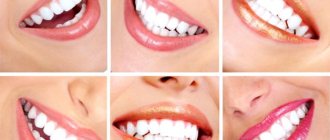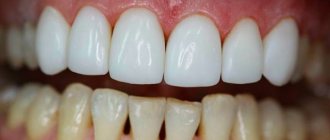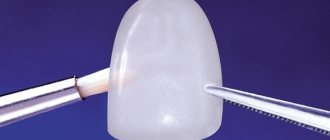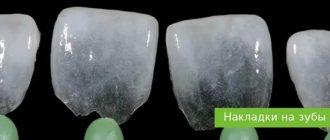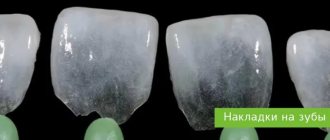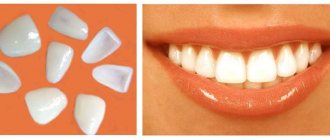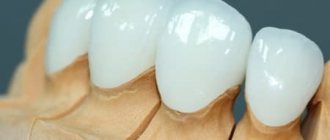Naturally perfectly beautiful and straight teeth are rare. 95% of people have some kind of dental defect that makes a person feel embarrassed about their own smile. Such defects include an unsightly shape, the presence of gaps between the elements of the dentition, an unaesthetic shade of the enamel (for example, yellowish or grayish), spots and cracks in the enamel. But all these defects can be eliminated: to do this, just contact the dentists, who will offer different options for acquiring a beautiful smile. And one of these options is lumineers for teeth.
In the article we will tell you in detail about what lumineers are, in what cases they are installed, how the installation of lumineers is carried out, and how much it will cost in Moscow.
What is this
Veneers, lumineers and ultraneers are overlays that are fixed to the front surface of the teeth. They serve to change the appearance, in some cases even the shape, of the teeth that make up our smile. They allow you to completely change the aesthetics of a row, making your teeth straight, white and without the slightest blemish. The overlays look like eye lenses - they are just as thin and even translucent.
An interesting fact: today almost all stars resort to the help of dentists to create a “Hollywood”, that is, a snow-white, dazzling smile. It’s enough to compare how they looked at the beginning of their careers and how they look now, after long and hard work on their appearance. Among the most convincing examples are Tom Cruise, David and Victoria Beckham, Nicolas Cage, Demi Moore and many others. Their smiles were transformed and became truly Hollywood.
How do you know if Lumineers are right for you?
It should be understood that installing lumineers in Moscow or any other city is not a quick process, requiring several visits to the clinic. At the first of them, you can ask the doctor to help you decide whether you need lumineers. To do this, the doctor will take a photo of your teeth, then use a computer to simulate a picture that will show the result of installing lumineers as close to reality as possible. If you like everything, impressions will be taken of your teeth and the dentist will send them to where the onlays are made, that is, in the USA. Why there? Because Lumineers are a patented technology, and only a few American laboratories have the right to manufacture them.
Indications and contraindications for use
- change in enamel color: yellow or dark teeth, especially in cases where the shade of the enamel cannot be changed with modern whitening methods;
- spaces between teeth (trema or diastema);
- old fillings;
- chips or cracks in enamel;
- protection of weak tooth enamel;
- slight change in the position of the teeth.
Contraindications to the installation of microprostheses are too weak enamel if it requires grinding (without grinding, onlays, on the contrary, protect the teeth from increased sensitivity), serious changes in the bite, teeth that are too long or too short, and severe gum disease. Also, the pads are not suitable for patients with bruxism (if you involuntarily clench your teeth too much, which leads to their grinding, the pads can simply come off due to excessive pressure).
When is it necessary to install lumineers?
Lumineers
There are indications for dentition correction with lumineers. You can get lumineers if you have:
- There are cracks and chips in your teeth;
- The color of the enamel has changed and cannot be bleached;
- There are gaps between the teeth;
- Malocclusions that do not affect health and do not need to be corrected with braces;
- If your teeth are prone to wear;
- Weak enamel, susceptible to damage;
- Uneven teeth that you want to correct;
- Various spots and spots that cannot be removed by other methods.
The color of lumineers is selected individually according to a special scale, so your teeth will look natural. Installation is carried out on the front teeth of at least 8 units. It is impossible to install a lumineer on one tooth, as it will be very different from the rest of the dentition.
Veneers, lumineers and ultraneers: what are the differences?
Dentist-therapist Alina Chilingaryan :
“ Veneers are the most basic concept. These are the onlays that opened up the market for microprosthetics. They are created in our country, in almost any dental laboratory. They have a thickness of 0.5-0.7 mm and so that they do not “stick out” beyond the dentition or thicken existing teeth, the surface of the tooth is slightly ground before installing veneers.
Lumineers are thinner veneers, their thickness is no more than 0.3 mm. They are fixed on the teeth without grinding. At the same time, they are created abroad using patented technology, which is reflected in their price - it is 2 times higher than the cost of veneers.
Ultraneers are modern thin veneers. They are created in Russia (at a plant in St. Petersburg) from special E.max ceramics and have a small thickness. Depending on the initial condition of the teeth and the defect that needs to be corrected, ultraneers can be fixed with either little or no grinding.”
Modern possibilities of lumineers
Lumineers are installed in the following cases:
- When the patient wants to get impeccable aesthetics - a Hollywood smile without a single flaw. Modern lumineers help disguise microcracks, chips, enamel erosion, as well as stains and streaks. They will correct the deficiency if your own tooth is too short;
- If using lumineers it is necessary to correct minor orthodontic problems - for example, when a tooth is slightly crooked;
- To get your teeth in perfect order, after installing veneers on filled teeth, you don’t need to worry that the filling has darkened and needs to be replaced. Lumineer masks all imperfections, while the tooth underneath remains healthy;
- If the patient wants to hide diastemas between teeth - gaps that create aesthetic discomfort;
- When there is a desire to replace old fillings, to hide the imperfections of the so-called tetracycline teeth;
- In cases where the initial natural color of the enamel is yellowish, grayish, and bleaching alone is not enough to obtain impeccable white teeth.
Unfortunately, it is not possible to install lumineers if:
- extensive caries;
- periodontitis;
- severe bite deformities;
- tendency to grind teeth.
Fortunately, the first three contraindications can be corrected. Caries – treat, bite – correct, gums – strengthen, after which you can plan the installation of lumineers.
Installation of onlays: stages of treatment
Installing onlays on teeth takes from 2-3 days to a month, depending on the type of microprosthesis chosen. In general, the patient will undergo the following treatment:
First visit:
- preparation of teeth: professional cleaning to remove plaque, tartar, treatment of caries or other diseases, if any,
- removing part of the enamel: this step is relevant only when installing veneers or ultraneers,
- taking impressions that will be used to create custom prostheses.
About 2-4 days pass between the first and second visit - this is the time it takes to make the dentures in the laboratory. However, if you choose lumineers, then about a month will pass between the stages, because the designs are developed abroad and sent to the Russian clinic.
Second visit:
- installation of prostheses: after the structures are created in the laboratory, they are tried on and, if necessary, adjusted. The surface of the teeth must be polished and treated with abrasive. Next, glue-cement is applied and the linings are tightly glued to the surface of the teeth.
What are the alternatives?
If for some reason lumineers are not suitable for you, you can consider classic veneers as an alternative: inexpensive composite veneers for single restorations, or made from pressed ceramic or zirconium. Both of the latter options have a fairly long service life, and in some situations they can be installed without grinding off the enamel. At the same time, their price is much lower.
1 Yudina N.A. Systematization of microprostheses of the anterior group of teeth and justification for the choice of aesthetic design: veneers, laminates, ultraneers, lumineers or composites. Modern dentistry, 2012. 2 According to the website russian-lumineers.ru
Veneers
Veneers are created from ordinary ceramics in almost any dental laboratory. The average thickness of the onlays is up to 1.5 mm, since ceramics is a fairly fragile material and if the prosthesis is made too thin, it will break even under minimal load.
Pros:
- quite high aesthetics,
- retain their original shape and color: ceramics do not shrink, plaque does not accumulate on it, the material does not change shade even under the influence of dyes,
- maximum accessibility: veneers can be installed in almost any clinic,
- fast treatment times, since the onlays are created in Russia.
- low cost relative to other overlays.
Minuses:
Among the disadvantages of the method are the impossibility of installation if the enamel is hypersensitive and the need for grinding of the teeth. The service life of veneers is less than lumineers and ultraneers (about 10 years)
Expert comment:
Alina Chilingaryan, dental therapist: “Veneers are the most affordable type of dental restoration, because their cost starts from 16 thousand rubles per tooth. And this is their main advantage. But don’t forget: despite the fact that dental veneers can last for several decades, if they come off, immediate re-prosthetics will be required due to previous grinding.”
How many lumineers should be placed on teeth to create a beautiful smile?
The number of plates depends on how many teeth are visible when smiling and what goals the patient is pursuing. If a person needs to correct the color or shape of only one tooth, then it is not necessary to cover the rest with lumineers - one is enough. Thanks to their exceptional ability to imitate natural tooth enamel, even a single lumineer easily blends in color with the surrounding teeth. How many Lumineers do you need to install to correct the aesthetics of your smile? This parameter is very individual. Sometimes 4 are enough, sometimes 6, or 8 or 10 for the upper teeth. Lumineers can also be installed on the lower teeth, or they can be bleached to match the color of the upper teeth.
Photos before and after dental restoration with lumineers at the Beauty Line clinic
Lumineers or “Hollywood veneers”
Lumineers are the most advanced dental coverings available today. Their thickness is no more than 0.5 mm. They are created by the American company Cerinate using patented technology, using modern computerized equipment (from treatment planning to creating the structures themselves).
Pros:
- the highest aesthetics - a special glue is used to attach the lumineers, which gives the dentures a special translucency, like natural teeth,
- naturalness - teeth with onlays look like natural ones,
- no need to grind your own teeth - the installation process is reversible and has no consequences for the enamel,
- preservation of shape: lumineers are resistant to external influences, do not change color, shape,
- the only method of protecting sensitive enamel,
- no anesthesia is required during installation,
- long service life - 20 years or more.
Minuses:
Among the disadvantages of treatment are the high cost and long treatment period. Remember that Lumineers are created only in America and only individually, so it is simply impossible to restore teeth in a couple of days - you need to be patient. And if you are offered Lumineers in just a week, this is a scam.
Expert comment:
Alina Chilingaryan, dental therapist: “The cost of lumineers is from 30,000 rubles for installation on one tooth. But the price is justified by the fact that the teeth look very natural. In addition, if necessary, lumineers can be removed - your own teeth will not be harmed at all. The service life of lumineers is at least 20 years, this is guaranteed by the manufacturer.”
Do ceramic lumineers have contraindications?
Lumineers have certain contraindications. For example, they are not recommended for patients with strongly protruding or very large front teeth - overlay plates will only emphasize the defect. In people with a strongly retracted lower jaw or lower teeth inclined inward, the load on the dentition is distributed incorrectly, which can cause some difficulties during the installation of lumineers. However, I can say from my own experience, and I have been working with this technology since 2005, that a good specialist will take on aesthetic correction even with such serious problems. By the way, the presence of fillings is not a contraindication, as is commonly believed by some experts.
Ultraneers or “E.max ultra-thin veneers”
Ultraneers are created from German-made E.max ceramics. They are much thinner than veneers, but slightly thicker than lumineers - their thickness is no more than 0.6 mm. Therefore, in some cases, it is possible to do without tooth preparation, or to carry out very minimal grinding.
Pros:
- excellent aesthetics comparable to Lumineers,
- an alternative to lumineers in almost all respects,
- maximum naturalness of the renewed dentition,
- preservation of the color and shape of the dentures,
- more durable ceramics than those used to create veneers, which is why ultraneers are thinner than veneers,
- fast production times for overlays, because they are created in Russia,
- long service life - 10 years or more.
Minuses:
Among the relative disadvantages of ultranir is, again, their cost. They are 30% cheaper than lumineers, but restoring the entire dentition will still cost a pretty penny. In addition, when installing ultraneers, it is often necessary to grind the teeth, albeit minimally.
Expert comment:
Alina Chilingaryan, dental therapist: “Ultraneers are an intermediate option between inexpensive veneers and high-priced lumineers. Their cost is 30% lower than lumineers, that is, about 20 thousand rubles per tooth. At the same time, they can be installed faster, since they are created in Russia. But in some cases you can’t do without turning.”
Doctors at our clinic
Shmatov Konstantin Vladimirovich
More about the doctor
Shalygin Andrey Viktorovich
More about the doctor
Kim Yulia Vyacheslavovna
More about the doctor
Dental care
The most important thing that every patient should remember is that he has dentures installed. And no matter how reliable, strong and durable they are, these are still artificial teeth. Just like living ones, they need special care - regular brushing and toothpaste, and mandatory regular dental checkups. You should not bite off too hard foods with your new teeth - even apples should be cut into small pieces, otherwise the lining may break off. Follow these simple rules and your new teeth will last you for decades.
What are the pros and cons of such prosthetics?
This method of restoration of minor dental defects has a whole list of undeniable advantages. Let us list the main advantages of microprostheses:
- the ability to hide defects quickly and with a guaranteed result,
- materials that are as resistant to pigmentation as possible are used to create the plates,
- Lumineers provide additional enamel protection,
- their installation is completely painless (anesthesia is used during turning),
- stunning aesthetic effect,
- long-term operation up to 10-20 years.
This method is used to eliminate interdental spaces
“I just got veneers on my front teeth six months ago. To be honest, I regret a little that I chose a more budget-friendly option and had to grind down the enamel. On the other hand, I would be able to achieve a similar effect only after several years with braces and chemical whitening, and this takes a long time and costs money.”
DmitriyS, Moscow, from a review on the website of one of the dental clinics
However, there are also disadvantages here, among which, first of all, it is worth highlighting the rather high fragility of the products. In addition, the price of such a smile is far from small, so the method is not available to all patients. In the case of veneers, you have to significantly grind down your living teeth, and this is irreversible. In addition, it is important to find a truly experienced specialist, since inaccuracies in the positioning of the pads can cause caries and gum inflammation.
Estimated cost - which method will cost more
Lumineers are a more expensive option for prosthetics, although today Russian manufacturers offer their own, more budget-friendly analogue of ultra-thin plates. Approximate prices for installation of products of different brands and from different materials are shown in the table below.
| Types of microprostheses | Approximate cost for 1 pad |
| Ceramic E.Max | 30 thousand rubles. |
| On a zirconium dioxide frame | 25 thousand rubles. |
| From ceramic composite | 20 thousand rubles. |
| Lumineer DUO | 45 thousand rubles. |
| Lumineer Cerinate | 65 thousand rubles. |
